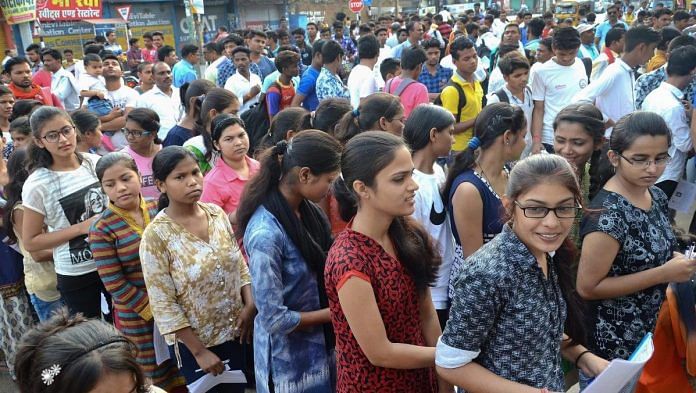New Delhi: Last Monday, when Tamil Nadu Chief Minister Stalin introduced a resolution in the state assembly, seeking an exemption from NEET, his government relied on a report submitted by a nine-member committee headed by Justice A.K. Rajan (retired).
The committee had submitted its 165-page report, on the impact of NEET in Tamil Nadu, to the government on 14 September; its contents were made public Monday.
According to the report, the National Eligibility-cum-Entrance Test (NEET) for undergraduate medical seats will send Tamil Nadu back to pre-Independence days, “when in small towns and in villages only bare-foot doctors were catering to patients”.
It also states that Tamil Nadu as a state would go down in rank among states in the medical and healthcare system.
The report further states that the exam in its current form discriminates against the poor, Tamil medium students and does not provide a level-playing field for students across financial backgrounds.
Also read: Why Tamil Nadu is not the first state to oppose NEET since implementation
NEET not a ‘criterion’-based examination
The committee, in its analysis, compared NEET with existing ‘criterion’-based exams such as Scholastic Aptitude Test (SAT), which have common standards and common syllabus.
“A criterion-based test is designed to assess students’ performance against a fixed set of predetermined standards or criteria, which at the level of secondary education is used to assess if students have acquired a specific body of knowledge or a specific skill set,” it states.
As an example, the committee states that the enrollment of students from CBSE has been higher since the implementation of NEET. Calling the exam “CBSE biased” the report reads, “The results have consistently proved that the students from the CBSE stream have secured MBBS seats as high as 26.83% in 2020-21 from 0% in 2015-16 in government medical colleges and 12.01% in 2020-21 from a negligible 0.07% in 2015-16 in self-financed colleges in this high stake exam.”
The committee also referred to validity tests conducted on international exams like MCAT, UCAT and SAT. These tests are done periodically to ensure their reliability in predicting the future performance of the students in the college. The committee claimed that since in the last four years, no such tests were conducted for NEET, and as such there is no predictable data to reflect the success in higher education of the students clearing NEET.
Merit-based admissions vs coaching
Analysis conducted by the committee found that 99 per cent of students who secured admission in medical colleges in 2019-20 had received prior training or coaching before they appeared in the NEET. Most of them had repeatedly taken the examination to get admission to MBBS. Many of them are being coached from Class 8 onwards, the report said, adding that students are mentally being prepared to concentrate on the NEET Examination.
The committee has argued that this takes away from the holistic learning that students require.
The committee also found that almost 97 per cent of the government school students’ parents’ annual income was less than Rs 1,00,000 annually. “In such a condition, when coaching demands Rs 3 lakh per year, how can they equip their kids for NEET? Wider literature findings also confirm that parents’ income plays a major role in their children’s education,” the report states.
4 years of NEET
The report in its observation found that the percentage of rural students came down from 65.17 per cent in 2016-17 in the pre-NEET year, to 49.91 per cent in 2020-21.
The number of Tamil-medium students allotted MBBS seats also came down from 14.88 per cent in 2016-17 to a mere 1.99 per cent in 2020-21. Data collected by the committee also found that the enrollment of students in state boards has declined post implementation of NEET.
“The ever increasing student size in HSC since 2011 till 2017 has slipped down to 12.7%, with a loss in student size of 113,322, between 2017 and 2020, in the post-NEET period.”
In addition to this, it also found that students now prefer studying in English medium classes over Tamil. “The Tamil medium students’ size went down by 24.8% whereas that of the English medium rose to 8.4% between the period of 2017 and 2020,” the report states.
To aid its argument that there has been a rise in CBSE students in medical colleges post-NEET, the study states, “There has been a huge rise in admission of CBSE board students to 22.66% in the govt seats in the post-NEET period from a meagre 0.1% in the pre-NEET, while the rate of admission of the TNBSE students to the govt colleges fell from 70.11% in the pre-NEET to 46.77% in the post-NEET.”
This, according to the committee, shows that the introduction of NEET as sole criteria for admission into medical colleges has adversely affected the share of seats that were historically enjoyed by the state board students. But it worked positively for the CBSE students. Also, the growing disinclination towards applying for MBBS among the TNBSE applicants, in the post-NEET period, shows that the NEET is the major obstacle that gradually prevents them from seeking admission in medical colleges.
(Edited by Arun Prashanth)
Also read: JEE scam and NEET ban are failures of the existing system. But tougher questions lie ahead






